FIAT 500 2020 Owner handbook (in English)
Manufacturer: FIAT, Model Year: 2020, Model line: 500, Model: FIAT 500 2020Pages: 228, PDF Size: 6.01 MB
Page 101 of 228
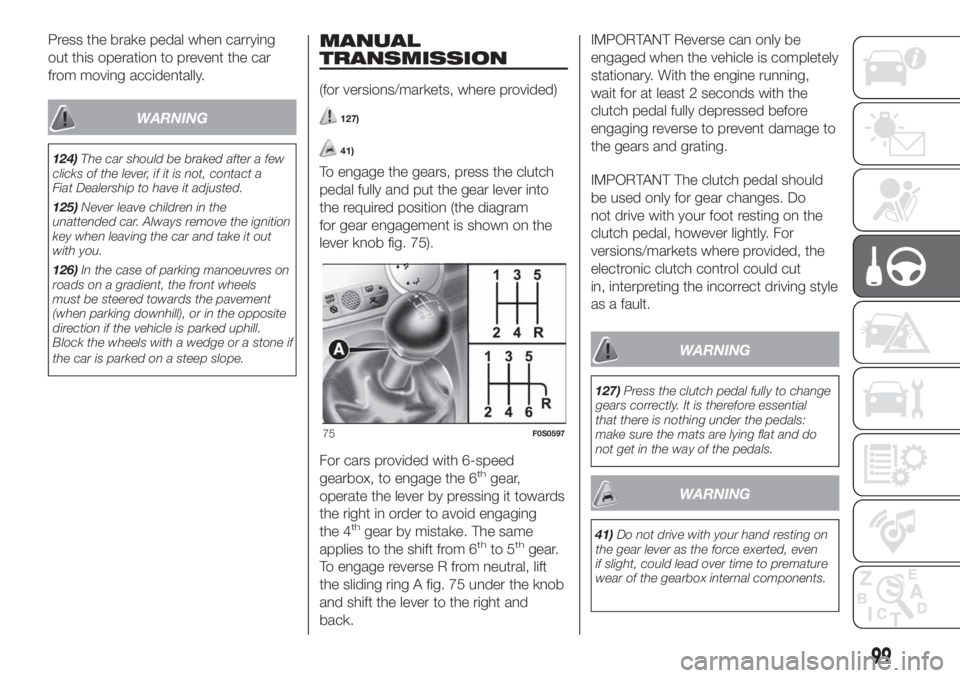
Press the brake pedal when carrying
out this operation to prevent the car
from moving accidentally.
WARNING
124)The car should be braked after a few
clicks of the lever, if it is not, contact a
Fiat Dealership to have it adjusted.
125)Never leave children in the
unattended car. Always remove the ignition
key when leaving the car and take it out
with you.
126)In the case of parking manoeuvres on
roads on a gradient, the front wheels
must be steered towards the pavement
(when parking downhill), or in the opposite
direction if the vehicle is parked uphill.
Block the wheels with a wedge or a stone if
the car is parked on a steep slope.
MANUAL
TRANSMISSION
(for versions/markets, where provided)
127)
41)
To engage the gears, press the clutch
pedal fully and put the gear lever into
the required position (the diagram
for gear engagement is shown on the
lever knob fig. 75).
For cars provided with 6-speed
gearbox, to engage the 6
thgear,
operate the lever by pressing it towards
the right in order to avoid engaging
the 4
thgear by mistake. The same
applies to the shift from 6thto 5thgear.
To engage reverse R from neutral, lift
the sliding ring A fig. 75 under the knob
and shift the lever to the right and
back.IMPORTANT Reverse can only be
engaged when the vehicle is completely
stationary. With the engine running,
wait for at least 2 seconds with the
clutch pedal fully depressed before
engaging reverse to prevent damage to
the gears and grating.
IMPORTANT The clutch pedal should
be used only for gear changes. Do
not drive with your foot resting on the
clutch pedal, however lightly. For
versions/markets where provided, the
electronic clutch control could cut
in, interpreting the incorrect driving style
as a fault.
WARNING
127)Press the clutch pedal fully to change
gears correctly. It is therefore essential
that there is nothing under the pedals:
make sure the mats are lying flat and do
not get in the way of the pedals.
WARNING
41)Do not drive with your hand resting on
the gear lever as the force exerted, even
if slight, could lead over time to premature
wear of the gearbox internal components.
75F0S0597
99
Page 102 of 228
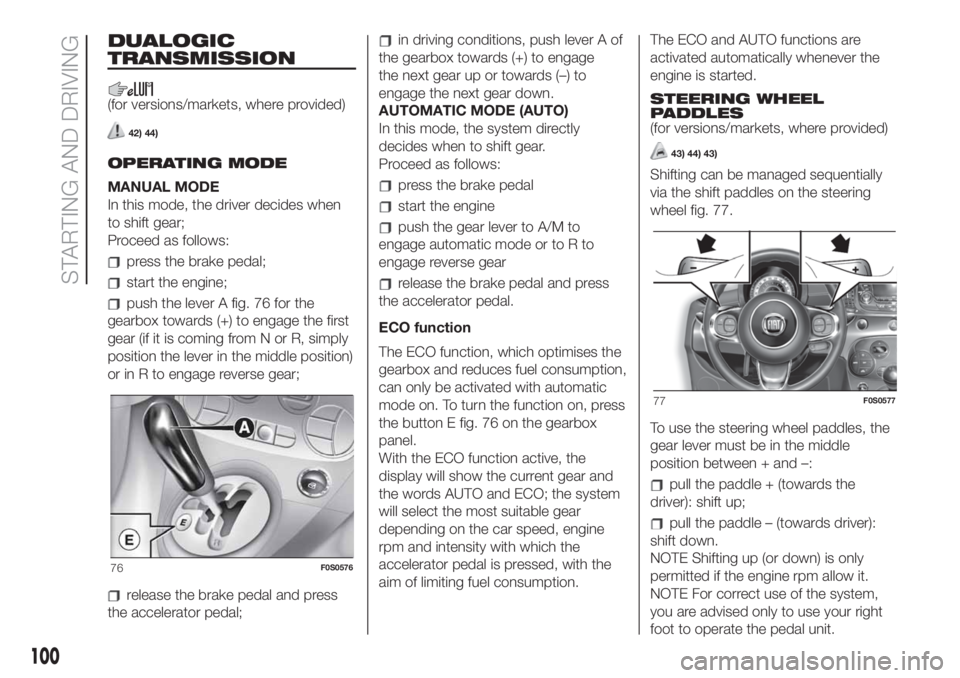
DUALOGIC
TRANSMISSION
(for versions/markets, where provided)
42) 44)
OPERATING MODE
MANUAL MODE
In this mode, the driver decides when
to shift gear;
Proceed as follows:
press the brake pedal;
start the engine;
push the lever A fig. 76 for the
gearbox towards (+) to engage the first
gear (if it is coming from N or R, simply
position the lever in the middle position)
or in R to engage reverse gear;
release the brake pedal and press
the accelerator pedal;
in driving conditions, push lever A of
the gearbox towards (+) to engage
the next gear up or towards (–) to
engage the next gear down.
AUTOMATIC MODE (AUTO)
In this mode, the system directly
decides when to shift gear.
Proceed as follows:
press the brake pedal
start the engine
push the gear lever to A/M to
engage automatic mode or to R to
engage reverse gear
release the brake pedal and press
the accelerator pedal.
ECO function
The ECO function, which optimises the
gearbox and reduces fuel consumption,
can only be activated with automatic
mode on. To turn the function on, press
the button E fig. 76 on the gearbox
panel.
With the ECO function active, the
display will show the current gear and
the words AUTO and ECO; the system
will select the most suitable gear
depending on the car speed, engine
rpm and intensity with which the
accelerator pedal is pressed, with the
aim of limiting fuel consumption.The ECO and AUTO functions are
activated automatically whenever the
engine is started.
STEERING WHEEL
PADDLES
(for versions/markets, where provided)
43) 44) 43)
Shifting can be managed sequentially
via the shift paddles on the steering
wheel fig. 77.
To use the steering wheel paddles, the
gear lever must be in the middle
position between + and –:
pull the paddle + (towards the
driver): shift up;
pull the paddle – (towards driver):
shift down.
NOTE Shifting up (or down) is only
permitted if the engine rpm allow it.
NOTE For correct use of the system,
you are advised only to use your right
foot to operate the pedal unit.
76F0S0576
77F0S0577
100
STARTING AND DRIVING
Page 103 of 228
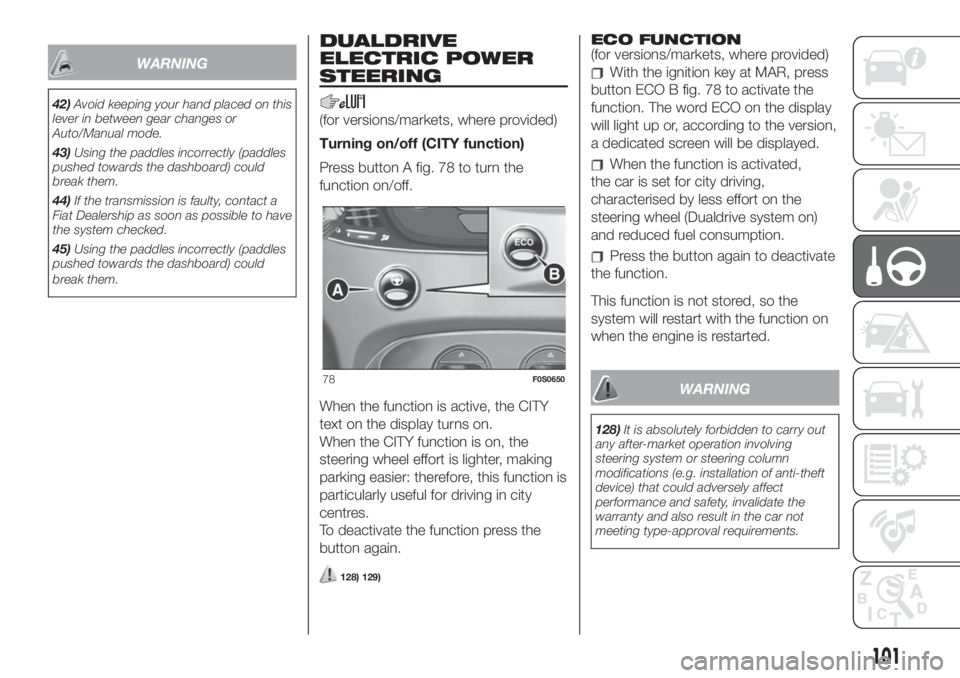
WARNING
42)Avoid keeping your hand placed on this
lever in between gear changes or
Auto/Manual mode.
43)Using the paddles incorrectly (paddles
pushed towards the dashboard) could
break them.
44)If the transmission is faulty, contact a
Fiat Dealership as soon as possible to have
the system checked.
45)Using the paddles incorrectly (paddles
pushed towards the dashboard) could
break them.
DUALDRIVE
ELECTRIC POWER
STEERING
(for versions/markets, where provided)
Turning on/off (CITY function)
Press button A fig. 78 to turn the
function on/off.
When the function is active, the CITY
text on the display turns on.
When the CITY function is on, the
steering wheel effort is lighter, making
parking easier: therefore, this function is
particularly useful for driving in city
centres.
To deactivate the function press the
button again.
128) 129)
ECO FUNCTION
(for versions/markets, where provided)
With the ignition key at MAR, press
button ECO B fig. 78 to activate the
function. The word ECO on the display
will light up or, according to the version,
a dedicated screen will be displayed.
When the function is activated,
the car is set for city driving,
characterised by less effort on the
steering wheel (Dualdrive system on)
and reduced fuel consumption.
Press the button again to deactivate
the function.
This function is not stored, so the
system will restart with the function on
when the engine is restarted.
WARNING
128)It is absolutely forbidden to carry out
any after-market operation involving
steering system or steering column
modifications (e.g. installation of anti-theft
device) that could adversely affect
performance and safety, invalidate the
warranty and also result in the car not
meeting type-approval requirements.
78F0S0650
101
Page 104 of 228
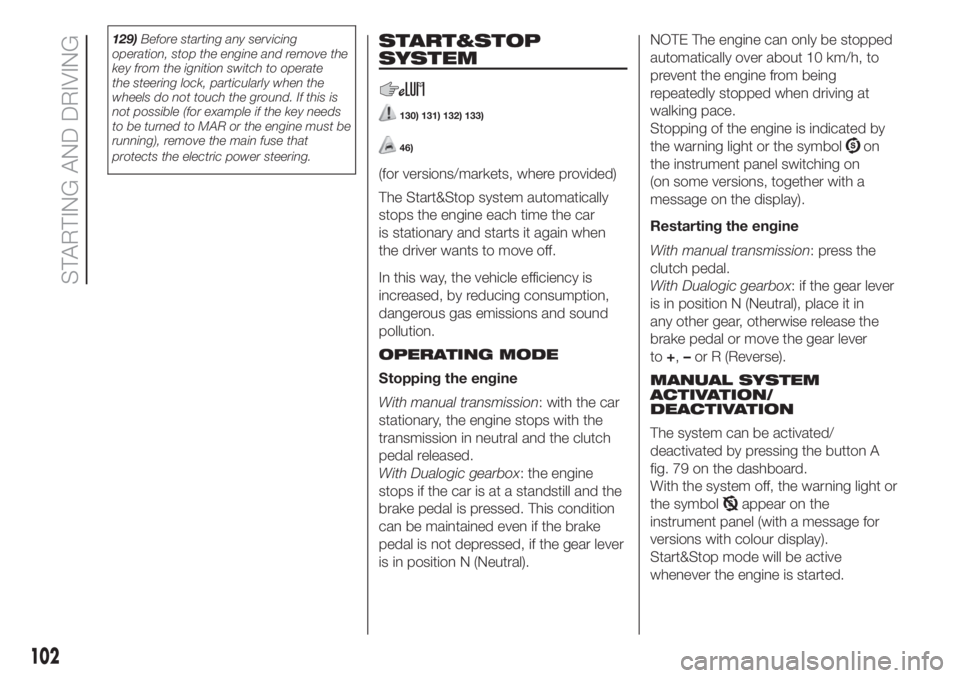
129)Before starting any servicing
operation, stop the engine and remove the
key from the ignition switch to operate
the steering lock, particularly when the
wheels do not touch the ground. If this is
not possible (for example if the key needs
to be turned to MAR or the engine must be
running), remove the main fuse that
protects the electric power steering.START&STOP
SYSTEM
130) 131) 132) 133)
46)
(for versions/markets, where provided)
The Start&Stop system automatically
stops the engine each time the car
is stationary and starts it again when
the driver wants to move off.
In this way, the vehicle efficiency is
increased, by reducing consumption,
dangerous gas emissions and sound
pollution.
OPERATING MODE
Stopping the engine
With manual transmission: with the car
stationary, the engine stops with the
transmission in neutral and the clutch
pedal released.
With Dualogic gearbox: the engine
stops if the car is at a standstill and the
brake pedal is pressed. This condition
can be maintained even if the brake
pedal is not depressed, if the gear lever
is in position N (Neutral).NOTE The engine can only be stopped
automatically over about 10 km/h, to
prevent the engine from being
repeatedly stopped when driving at
walking pace.
Stopping of the engine is indicated by
the warning light or the symbol
on
the instrument panel switching on
(on some versions, together with a
message on the display).
Restarting the engine
With manual transmission: press the
clutch pedal.
With Dualogic gearbox: if the gear lever
is in position N (Neutral), place it in
any other gear, otherwise release the
brake pedal or move the gear lever
to+,–or R (Reverse).
MANUAL SYSTEM
ACTIVATION/
DEACTIVATION
The system can be activated/
deactivated by pressing the button A
fig. 79 on the dashboard.
With the system off, the warning light or
the symbol
appear on the
instrument panel (with a message for
versions with colour display).
Start&Stop mode will be active
whenever the engine is started.
102
STARTING AND DRIVING
Page 105 of 228
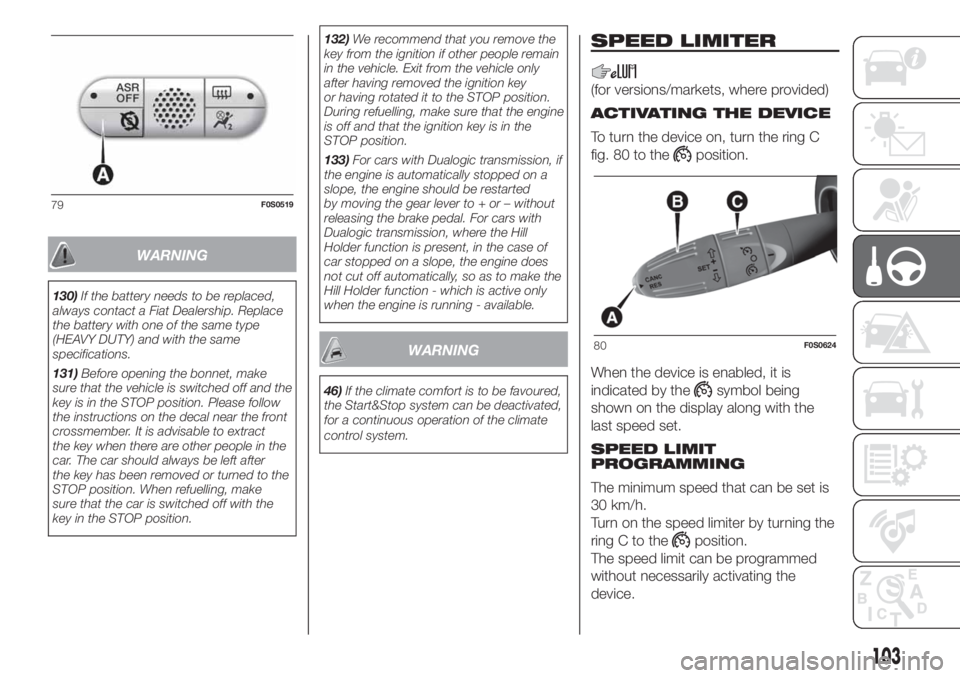
WARNING
130)If the battery needs to be replaced,
always contact a Fiat Dealership. Replace
the battery with one of the same type
(HEAVY DUTY) and with the same
specifications.
131)Before opening the bonnet, make
sure that the vehicle is switched off and the
key is in the STOP position. Please follow
the instructions on the decal near the front
crossmember. It is advisable to extract
the key when there are other people in the
car. The car should always be left after
the key has been removed or turned to the
STOP position. When refuelling, make
sure that the car is switched off with the
key in the STOP position.132)We recommend that you remove the
key from the ignition if other people remain
in the vehicle. Exit from the vehicle only
after having removed the ignition key
or having rotated it to the STOP position.
During refuelling, make sure that the engine
is off and that the ignition key is in the
STOP position.
133)For cars with Dualogic transmission, if
the engine is automatically stopped on a
slope, the engine should be restarted
by moving the gear lever to + or – without
releasing the brake pedal. For cars with
Dualogic transmission, where the Hill
Holder function is present, in the case of
car stopped on a slope, the engine does
not cut off automatically, so as to make the
Hill Holder function - which is active only
when the engine is running - available.
WARNING
46)If the climate comfort is to be favoured,
the Start&Stop system can be deactivated,
for a continuous operation of the climate
control system.
SPEED LIMITER
(for versions/markets, where provided)
ACTIVATING THE DEVICE
To turn the device on, turn the ring C
fig. 80 to the
position.
When the device is enabled, it is
indicated by the
symbol being
shown on the display along with the
last speed set.
SPEED LIMIT
PROGRAMMING
The minimum speed that can be set is
30 km/h.
Turn on the speed limiter by turning the
ring C to the
position.
The speed limit can be programmed
without necessarily activating the
device.
79F0S0519
80F0S0624
103
Page 106 of 228
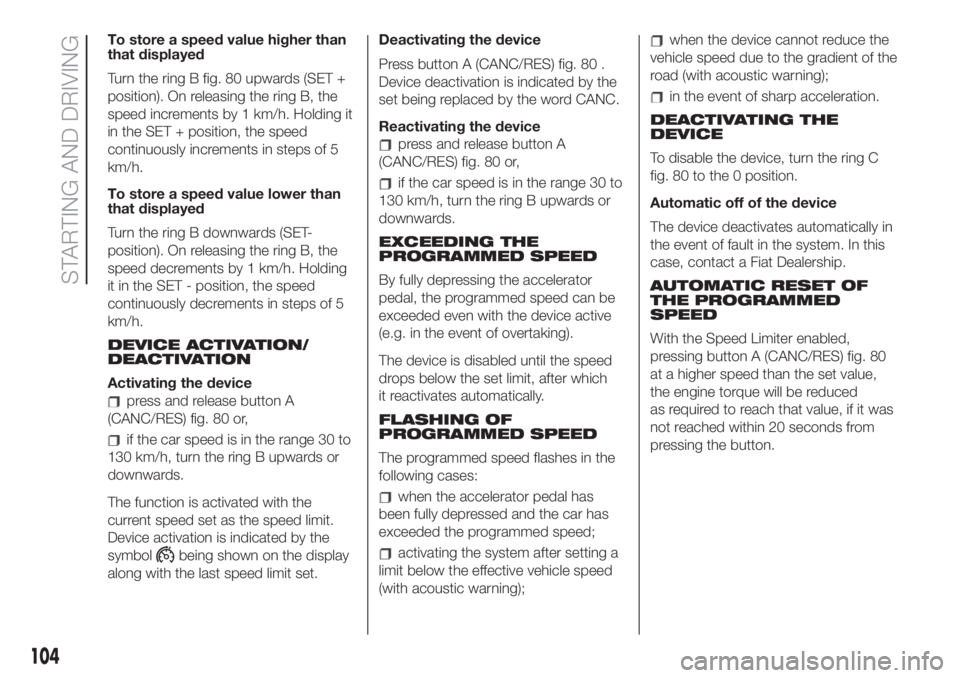
To store a speed value higher than
that displayed
Turn the ring B fig. 80 upwards (SET +
position). On releasing the ring B, the
speed increments by 1 km/h. Holding it
in the SET + position, the speed
continuously increments in steps of 5
km/h.
To store a speed value lower than
that displayed
Turn the ring B downwards (SET-
position). On releasing the ring B, the
speed decrements by 1 km/h. Holding
it in the SET - position, the speed
continuously decrements in steps of 5
km/h.
DEVICE ACTIVATION/
DEACTIVATION
Activating the device
press and release button A
(CANC/RES) fig. 80 or,
if the car speed is in the range 30 to
130 km/h, turn the ring B upwards or
downwards.
The function is activated with the
current speed set as the speed limit.
Device activation is indicated by the
symbol
being shown on the display
along with the last speed limit set.Deactivating the device
Press button A (CANC/RES) fig. 80 .
Device deactivation is indicated by the
set being replaced by the word CANC.
Reactivating the device
press and release button A
(CANC/RES) fig. 80 or,
if the car speed is in the range 30 to
130 km/h, turn the ring B upwards or
downwards.
EXCEEDING THE
PROGRAMMED SPEED
By fully depressing the accelerator
pedal, the programmed speed can be
exceeded even with the device active
(e.g. in the event of overtaking).
The device is disabled until the speed
drops below the set limit, after which
it reactivates automatically.
FLASHING OF
PROGRAMMED SPEED
The programmed speed flashes in the
following cases:
when the accelerator pedal has
been fully depressed and the car has
exceeded the programmed speed;
activating the system after setting a
limit below the effective vehicle speed
(with acoustic warning);
when the device cannot reduce the
vehicle speed due to the gradient of the
road (with acoustic warning);
in the event of sharp acceleration.
DEACTIVATING THE
DEVICE
To disable the device, turn the ring C
fig. 80 to the 0 position.
Automatic off of the device
The device deactivates automatically in
the event of fault in the system. In this
case, contact a Fiat Dealership.
AUTOMATIC RESET OF
THE PROGRAMMED
SPEED
With the Speed Limiter enabled,
pressing button A (CANC/RES) fig. 80
at a higher speed than the set value,
the engine torque will be reduced
as required to reach that value, if it was
not reached within 20 seconds from
pressing the button.
104
STARTING AND DRIVING
Page 107 of 228
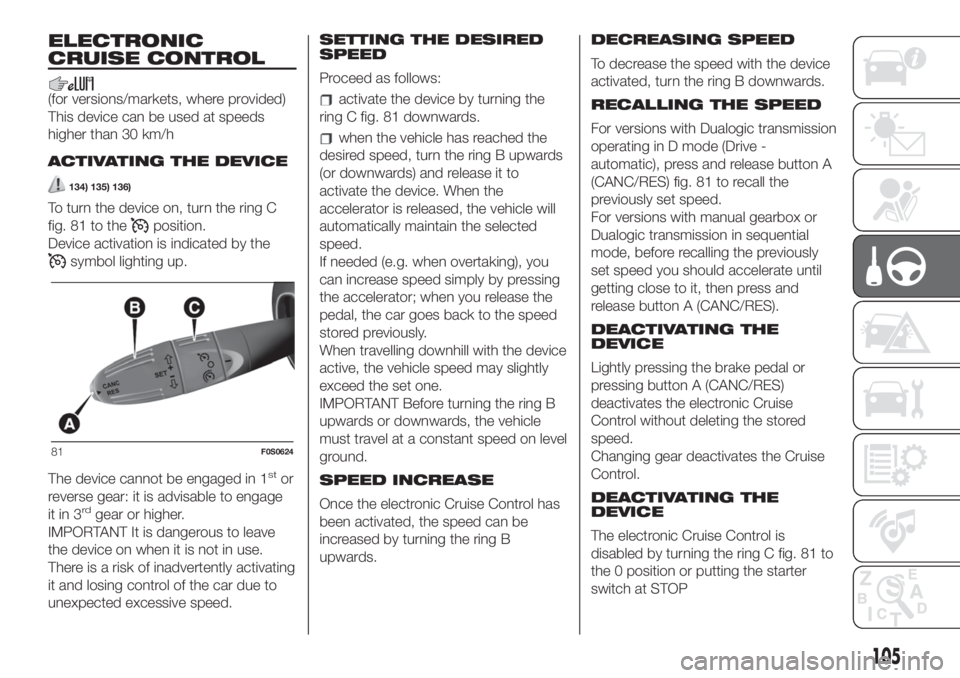
ELECTRONIC
CRUISE CONTROL
(for versions/markets, where provided)
This device can be used at speeds
higher than 30 km/h
ACTIVATING THE DEVICE
134) 135) 136)
To turn the device on, turn the ring C
fig. 81 to the
position.
Device activation is indicated by the
symbol lighting up.
The device cannot be engaged in 1
stor
reverse gear: it is advisable to engage
it in 3
rdgear or higher.
IMPORTANT It is dangerous to leave
the device on when it is not in use.
There is a risk of inadvertently activating
it and losing control of the car due to
unexpected excessive speed.SETTING THE DESIRED
SPEED
Proceed as follows:
activate the device by turning the
ring C fig. 81 downwards.
when the vehicle has reached the
desired speed, turn the ring B upwards
(or downwards) and release it to
activate the device. When the
accelerator is released, the vehicle will
automatically maintain the selected
speed.
If needed (e.g. when overtaking), you
can increase speed simply by pressing
the accelerator; when you release the
pedal, the car goes back to the speed
stored previously.
When travelling downhill with the device
active, the vehicle speed may slightly
exceed the set one.
IMPORTANT Before turning the ring B
upwards or downwards, the vehicle
must travel at a constant speed on level
ground.
SPEED INCREASE
Once the electronic Cruise Control has
been activated, the speed can be
increased by turning the ring B
upwards.DECREASING SPEED
To decrease the speed with the device
activated, turn the ring B downwards.
RECALLING THE SPEED
For versions with Dualogic transmission
operating in D mode (Drive -
automatic), press and release button A
(CANC/RES) fig. 81 to recall the
previously set speed.
For versions with manual gearbox or
Dualogic transmission in sequential
mode, before recalling the previously
set speed you should accelerate until
getting close to it, then press and
release button A (CANC/RES).
DEACTIVATING THE
DEVICE
Lightly pressing the brake pedal or
pressing button A (CANC/RES)
deactivates the electronic Cruise
Control without deleting the stored
speed.
Changing gear deactivates the Cruise
Control.
DEACTIVATING THE
DEVICE
The electronic Cruise Control is
disabled by turning the ring C fig. 81 to
the 0 position or putting the starter
switch at STOP
81F0S0624
105
Page 108 of 228
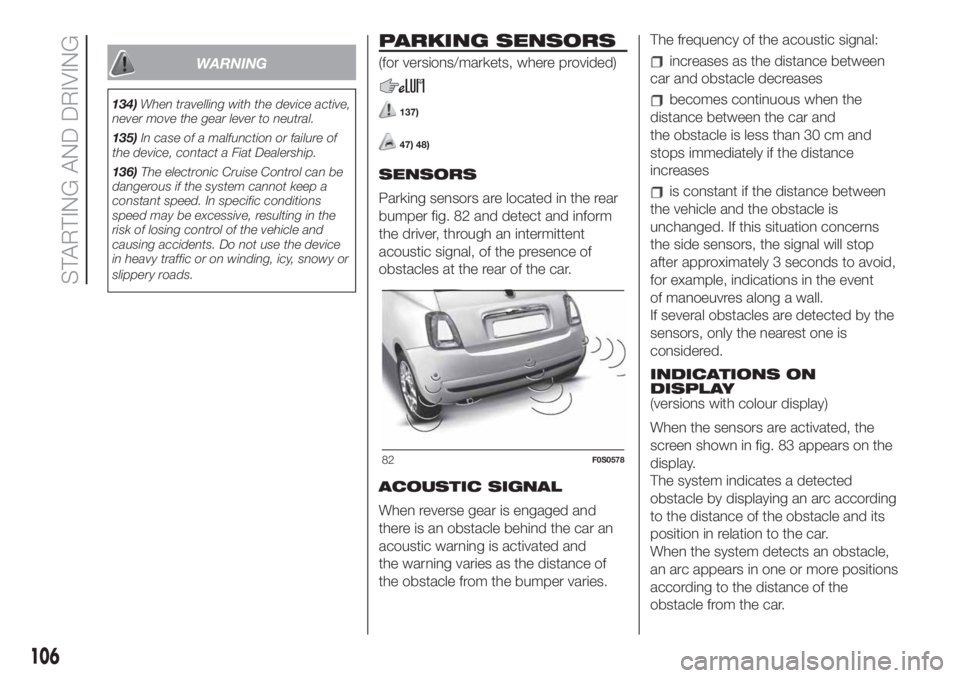
WARNING
134)When travelling with the device active,
never move the gear lever to neutral.
135)In case of a malfunction or failure of
the device, contact a Fiat Dealership.
136)The electronic Cruise Control can be
dangerous if the system cannot keep a
constant speed. In specific conditions
speed may be excessive, resulting in the
risk of losing control of the vehicle and
causing accidents. Do not use the device
in heavy traffic or on winding, icy, snowy or
slippery roads.
PARKING SENSORS
(for versions/markets, where provided)
137)
47) 48)
SENSORS
Parking sensors are located in the rear
bumper fig. 82 and detect and inform
the driver, through an intermittent
acoustic signal, of the presence of
obstacles at the rear of the car.
ACOUSTIC SIGNAL
When reverse gear is engaged and
there is an obstacle behind the car an
acoustic warning is activated and
the warning varies as the distance of
the obstacle from the bumper varies.The frequency of the acoustic signal:
increases as the distance between
car and obstacle decreases
becomes continuous when the
distance between the car and
the obstacle is less than 30 cm and
stops immediately if the distance
increases
is constant if the distance between
the vehicle and the obstacle is
unchanged. If this situation concerns
the side sensors, the signal will stop
after approximately 3 seconds to avoid,
for example, indications in the event
of manoeuvres along a wall.
If several obstacles are detected by the
sensors, only the nearest one is
considered.
INDICATIONS ON
DISPLAY
(versions with colour display)
When the sensors are activated, the
screen shown in fig. 83 appears on the
display.
The system indicates a detected
obstacle by displaying an arc according
to the distance of the obstacle and its
position in relation to the car.
When the system detects an obstacle,
an arc appears in one or more positions
according to the distance of the
obstacle from the car.
82F0S0578
106
STARTING AND DRIVING
Page 109 of 228
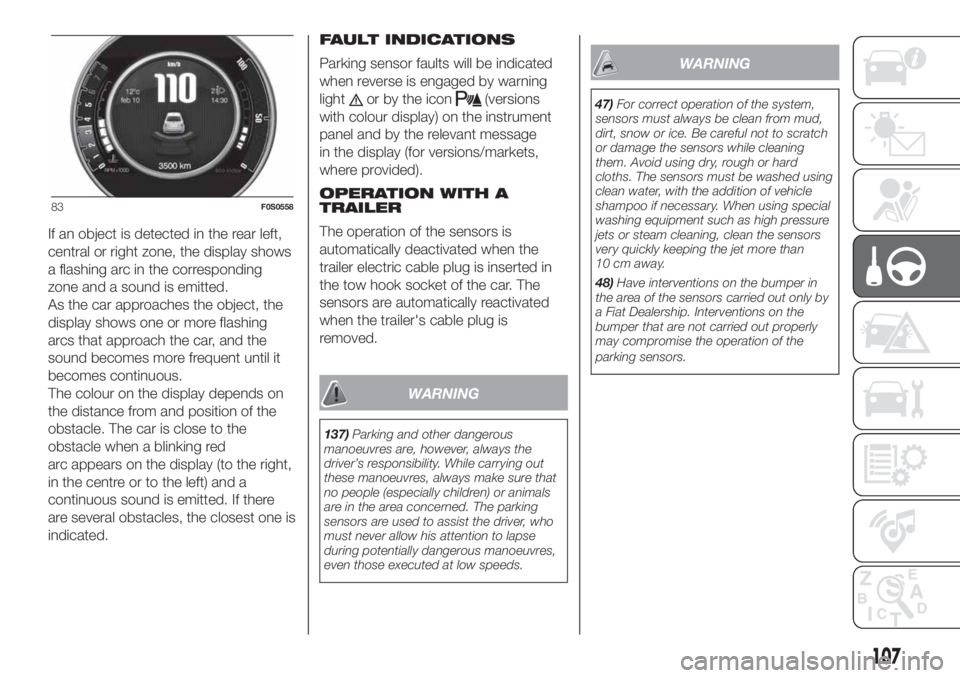
If an object is detected in the rear left,
central or right zone, the display shows
a flashing arc in the corresponding
zone and a sound is emitted.
As the car approaches the object, the
display shows one or more flashing
arcs that approach the car, and the
sound becomes more frequent until it
becomes continuous.
The colour on the display depends on
the distance from and position of the
obstacle. The car is close to the
obstacle when a blinking red
arc appears on the display (to the right,
in the centre or to the left) and a
continuous sound is emitted. If there
are several obstacles, the closest one is
indicated.FAULT INDICATIONS
Parking sensor faults will be indicated
when reverse is engaged by warning
light
or by the icon(versions
with colour display) on the instrument
panel and by the relevant message
in the display (for versions/markets,
where provided).
OPERATION WITH A
TRAILER
The operation of the sensors is
automatically deactivated when the
trailer electric cable plug is inserted in
the tow hook socket of the car. The
sensors are automatically reactivated
when the trailer's cable plug is
removed.
WARNING
137)Parking and other dangerous
manoeuvres are, however, always the
driver’s responsibility. While carrying out
these manoeuvres, always make sure that
no people (especially children) or animals
are in the area concerned. The parking
sensors are used to assist the driver, who
must never allow his attention to lapse
during potentially dangerous manoeuvres,
even those executed at low speeds.
WARNING
47)For correct operation of the system,
sensors must always be clean from mud,
dirt, snow or ice. Be careful not to scratch
or damage the sensors while cleaning
them. Avoid using dry, rough or hard
cloths. The sensors must be washed using
clean water, with the addition of vehicle
shampoo if necessary. When using special
washing equipment such as high pressure
jets or steam cleaning, clean the sensors
very quickly keeping the jet more than
10 cm away.
48)Have interventions on the bumper in
the area of the sensors carried out only by
a Fiat Dealership. Interventions on the
bumper that are not carried out properly
may compromise the operation of the
parking sensors.
83F0S0558
107
Page 110 of 228

SUGGESTIONS FOR
DRIVING
SAVING FUEL
Below are some suggestions which
may help you save fuel and thus lower
the amount of harmful emissions
released into the atmosphere.
Vehicle maintenance
Checks and operations should be
carried out in accordance with
the "Scheduled Servicing Plan" (see the
"Maintenance and care" chapter).
Tyres
Check the tyre pressures at least once
every four weeks: if the pressure is
too low, consumption levels increase as
resistance to rolling is higher.
Unnecessary loads
Do not travel with an overloaded
luggage compartment. The weight of
the vehicle and its arrangement greatly
affect fuel consumption and stability.Roof rack/ski rack
Remove the roof rack or the ski rack
from the roof when they are not used.
These accessories lower aerodynamic
penetration and adversely affect
consumption levels. When transporting
particularly large objects, use a trailer
if possible.
Electric devices
Use electrical devices only for the
amount of time needed. The heated
rear window, windscreen wipers and
heater fan require a considerable
amount of energy; increasing
the current uptake increases fuel
consumption (by up to +25% in an
urban cycle).
Climate control module
Using the climate control system will
increase consumption: use standard
ventilation when the temperature
outside permits.
Devices for aerodynamic control
The use of non-certified devices for
aerodynamic control may adversely
affect air drag and consumption levels.DRIVING STYLE
Start
Do not warm up the engine at low or
high revs when the car is stationary;
this causes the engine to warm up
more slowly, thereby increasing fuel
consumption and emissions. It is
therefore advisable to move off
immediately, slowly, avoiding high
speeds: in this way the engine will
warm up more quickly.
Unnecessary actions
Avoid revving up when starting at traffic
lights or before stopping the engine.
The latter action, as well as double-
declutching, is unnecessary and causes
increased fuel consumption and
pollution.
Gear selection
Use a high gear when traffic and road
conditions allow it. Using a low gear for
faster acceleration will increase fuel
consumption. In the same way,
improper use of a high gear increases
consumption, emissions and engine
wear.
108
STARTING AND DRIVING